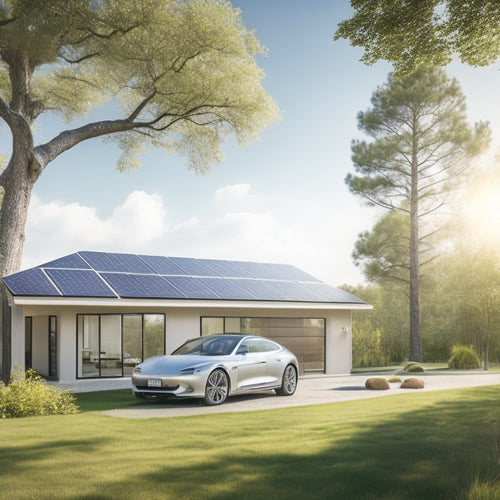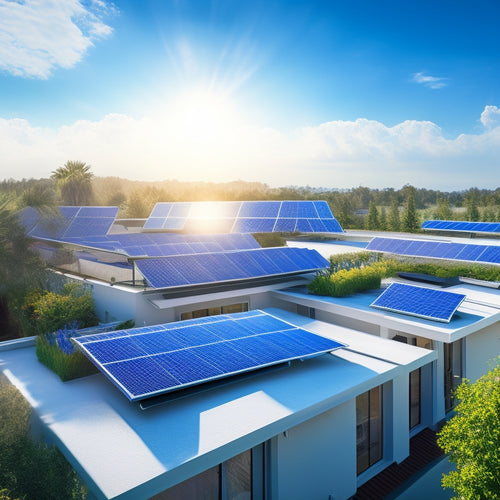
Alternative Solar Panel Installation Methods Beyond Traditional Mounts
Share
You're looking beyond traditional solar panel mounts to explore alternative installation methods that can reduce costs, enhance aesthetics, and increase energy efficiency. Consider building-integrated photovoltaics (BIPV) systems, solar roofs with energy-harvesting tiles, or innovative rail-free mounting solutions. You might also explore floating solar panels on water, solar windows with energy-generating glass, or vertical solar panel installation. These alternative methods can provide a more seamless integration with your property while reducing installation time and labor costs. As you explore these options, you'll discover even more innovative solutions to maximize your solar panel's potential.
Key Takeaways
• Alternative solar panel installation methods offer innovative solutions beyond traditional mounts, enhancing aesthetics and energy efficiency.
• Building-integrated photovoltaics (BIPV) systems integrate solar panels into building structures, providing a seamless and modern look.
• Innovative rail-free mounting solutions reduce installation time and labor costs, making solar panel installation more cost-effective.
• Solar windows with energy-generating glass and solar roofs with energy-harvesting tiles provide a sleek and modern alternative to traditional solar panels.
• Vertical solar panel installation and solar canopies for parking and walkways offer unique and space-saving solutions for urban environments.
Building-Integrated Photovoltaics (BIPV) Systems
You can integrate Building-Integrated Photovoltaics (BIPV) Systems directly into your building's architecture, replacing traditional roofing materials with solar panels that generate electricity while serving as a weather-tight barrier.
This innovative approach to solar panel installation offers a seamless Architectural Integration, blending functionality with aesthetics. By incorporating BIPV Systems into your building design, you can enhance Energy Efficiency while reducing your carbon footprint.
The system's energy-generating capabilities are matched only by its ability to provide a durable, long-lasting, and weather-resistant exterior envelope. As a result, BIPV Systems offer a unique opportunity to create sustainable, energy-positive buildings that not only reduce energy consumption but also produce clean energy.
Solar Roofs With Energy-Harvesting Tiles
Solar roofs with energy-harvesting tiles integrate photovoltaic technology into individual roofing tiles, allowing homeowners to generate electricity while maintaining a traditional roofing aesthetic. This innovative approach to solar energy harvesting offers a unique blend of form and function, providing a seamless integration of solar power into your home's design. You can enjoy the benefits of renewable energy without compromising on the visual appeal of your roof.
| Feature | Benefit |
|---|---|
| Solar Aesthetics | Preserves traditional roofing look and feel |
| Roof Integration | Streamlined installation and maintenance |
| Energy Harvesting | Generates electricity while maintaining a traditional roof design |
As you consider solar roofs with energy-harvesting tiles, keep in mind that this technology offers a perfect blend of sustainability and style. By integrating solar panels into individual roofing tiles, you can create a sleek, modern look that also reduces your carbon footprint. With solar roofs, you can enjoy the benefits of renewable energy while maintaining a traditional roofing aesthetic.
Innovative Rail-Free Mounting Solutions
Innovative rail-free mounting solutions are redefining the way solar panels are installed, offering a more streamlined and efficient approach that eliminates the need for traditional rails and clamps.
You'll appreciate the simplicity and flexibility of these systems, which enable quicker installation and reduced material costs.
Clip-on systems, for instance, allow you to securely fasten solar panels to your roof without the need for cumbersome rails. This not only reduces visual clutter but also minimizes the risk of water infiltration and associated structural damage.
Hidden frames are another innovative solution, providing a sleek, low-profile design that complements your roof's architecture. These frames are cleverly concealed, creating a seamless integration with your roof's surface.
Floating Solar Panels on Water
Floating photovoltaic panels on water, also known as floatovoltaics, have emerged as a promising solution for harnessing renewable energy from aquatic environments, including reservoirs, lakes, and coastal areas.
You can now consider this innovative approach to generate clean energy while preserving aquatic ecosystems. By installing solar panels on water, you'll reduce the impact on land use, preserving natural habitats and biodiversity. This method also helps maintain water quality by reducing evaporation and suppressing algae growth, which can harm aquatic life.
Additionally, the water's cooling effect can increase the efficiency of the solar panels. As you explore this alternative, consider the benefits of reduced visual pollution, increased energy production, and potential synergies with existing water management infrastructure.
Solar Windows With Energy-Generating Glass
As you explore solar windows with energy-generating glass, you'll find that energy-harvesting window panes are a key component. These innovative panes integrate photovoltaic cells into the glass, allowing buildings to generate electricity while still maintaining transparency.
Building-integrated photovoltaics (BIPV) takes this concept further, seamlessly integrating energy generation into building facades and rooftops.
Energy-Harvesting Window Panes
You're now able to integrate energy-harvesting capabilities into your building's façade with energy-harvesting window panes, which seamlessly merge solar panels with traditional glazing. These innovative windows, also known as Smart Glass, generate electricity while still allowing light to pass through, making them an attractive option for architects and builders.
The energy-harvesting technology is integrated into the glass, eliminating the need for separate solar panels, and can be easily incorporated into new buildings or retrofitted into existing structures. This architectural integration allows for a sleek, modern design that not only reduces carbon emissions but also provides a sustainable source of energy.
Additionally, energy-harvesting window panes can be tailored to meet specific energy demands, making them an ideal solution for buildings with high energy requirements. By incorporating these cutting-edge windows into your design, you can create a more sustainable, energy-efficient, and environmentally friendly building that benefits both the occupants and the planet.
Building-Integrated Photovoltaics
Building-integrated photovoltaics, also known as solar windows with energy-generating glass, involve the direct integration of solar panels into a building's envelope. This provides a unique opportunity to transform architectural elements into power-generating systems.
As you explore this innovative approach, you'll discover that building-integrated photovoltaics (BIPV) can be seamlessly integrated into a building's design. This integration enhances its aesthetic appeal while generating clean energy.
Agrivoltaics: Solar Farms and Crops
As you explore agrivoltaics, you'll find that it's not just about installing solar panels on farmland, but also about maximizing land use.
You'll need to take into account the dual benefits of growing crops under solar panels, selecting the right crops to thrive in shaded conditions, and mitigating the effects of shading on crop growth.
Dual Land Use Benefits
By integrating solar panels into agricultural landscapes, agrivoltaics offers a promising opportunity to maximize land use efficiency and promote sustainable coexistence of solar farms and crops. As you explore this innovative approach, you'll discover the dual land use benefits that come with it.
By sharing land between solar panels and crops, you can create an agricultural synergy that enhances the overall productivity of the land. This land sharing approach not only generates clean energy but also increases crop yields, reduces water evaporation, and provides shade for livestock.
You'll be able to utilize the same land for both solar energy production and agricultural purposes, making the most of the available space. This dual use of land also opens up new revenue streams for farmers, who can benefit from selling both their crops and the generated solar energy.
Crop Selection Strategies
Selecting compatible crops that thrive under the partial shade and unique microclimate created by solar panels is essential to maximizing the productivity of your agrivoltaic system. You'll want to choose crops that are adapted to the specific conditions of your solar farm, taking into account factors like temperature, humidity, and light intensity.
Crop rotation is a key strategy to maintain soil health and prevent pests and diseases from taking hold. By rotating crops, you can also optimize the use of nutrients and reduce the need for fertilizers.
When selecting crops, consider those that are naturally shade-tolerant, such as leafy greens, herbs, and some fruiting crops like strawberries. These crops won't only thrive under the partial shade but also benefit from the reduced soil temperature and increased humidity.
Additionally, incorporating cover crops into your rotation can help improve soil health by adding organic matter and reducing erosion. By carefully selecting and rotating your crops, you can create a resilient and productive agrivoltaic system that benefits both your farm and the environment.
Shading Effects Mitigation
Your agrivoltaic system's shading effects can be mitigated through strategic planning and design, ensuring that the benefits of solar energy and crop production are maximized while minimizing negative impacts.
Shading from trees, buildings, or other obstructions can greatly reduce the efficiency of your solar panels. To overcome this, conducting an obstruction analysis to identify potential shading sources is crucial.
To mitigate shading effects, consider the following strategies:
-
Tree pruning: Regular pruning of trees can help reduce shading effects by allowing more sunlight to reach your solar panels.
-
Panel placement optimization: Strategically placing your solar panels to minimize shading from obstructions can significantly improve their efficiency.
-
Shading-tolerant crop selection: Selecting crop varieties that are tolerant of partial shading can help minimize the impact of shading on crop yields.
Vertical Solar Panel Installation
When installing solar panels vertically, you'll typically mount them on a wall or a fence, allowing for more efficient use of space in areas with limited roof access. This approach is particularly useful in urban areas where rooftops may be small or irregularly shaped.
By installing solar panels vertically, you can optimize space and generate clean energy while maintaining a visually appealing urban landscape. In fact, vertical solar panel installation can be a game-changer for urban landscaping, as it enables homeowners and businesses to harness renewable energy without sacrificing aesthetic appeal.
By integrating solar panels into building facades or fences, you can create a seamless blend of form and function. Additionally, vertical installation can help reduce the visual impact of solar panels, making them less obtrusive and more acceptable in historic districts or areas with strict architectural regulations.
Solar Canopies for Parking and Walkways
By incorporating solar canopies into parking and walkway infrastructure, you can generate clean energy while providing shade and protection from the elements. This innovative approach not only reduces our reliance on fossil fuels but also enhances the overall user experience. Solar canopies can be designed to blend seamlessly into the surrounding architecture, offering a sleek and modern aesthetic that complements any environment.
Some key benefits of solar canopies include:
-
Parking Shade: Providing a comfortable and shaded area for vehicles, reducing heat gain and increasing user comfort.
-
Solar Aesthetics: Customizable designs that integrate solar panels into the canopy structure, creating a visually appealing and sustainable solution.
-
Increased Property Value: Enhancing the attractiveness and functionality of a property, potentially increasing its value and appeal.
Integrated Solar Panel Facades
As you explore innovative ways to harness solar energy, integrated solar panel facades are an attractive option. Architects and builders are increasingly incorporating integrated solar panel facades into building designs, effectively turning exterior walls into energy-harvesting surfaces that reduce reliance on traditional power sources.
This integration not only generates clean energy but also enhances the building's aesthetic appeal. By incorporating solar panels into the facade design, you can achieve a sleek, modern look while decreasing energy costs.
When designing a building with integrated solar panel facades, energy efficiency is a top priority. The facade's energy-harvesting capabilities can notably reduce the building's energy consumption, making it an attractive option for environmentally conscious architects and builders.
Solar Shingles for Residential Roofing
When you consider solar shingles for your residential roofing, you're looking at a unique opportunity to integrate energy-harvesting functionality into your home's design.
Building Integrated Photovoltaics (BIPV) allow you to generate electricity while maintaining a seamless roofing aesthetic.
Building Integrated Photovoltaics
You can integrate solar panels into your residential roofing with Building Integrated Photovoltaics (BIPV), an innovative technology that replaces traditional roofing materials with solar panels that generate electricity while serving as a waterproofing layer. This architectural innovation opens up new possibilities for energy efficiency in residential buildings.
With BIPV, you can harness the power of the sun while reducing your reliance on traditional energy sources.
Here are some benefits of incorporating BIPV into your roofing:
-
Aesthetically pleasing: BIPV systems blend seamlessly into your roof's design, providing a sleek and modern look.
-
Energy-efficient: By generating electricity on-site, you can reduce your energy consumption and lower your utility bills.
-
Durable and long-lasting: BIPV systems are designed to last for decades, providing a reliable source of clean energy for years to come.
Energy-Harvesting Roof Tiles
Energy-harvesting roof tiles, also known as solar shingles, seamlessly integrate into your residential roofing, generating clean energy while serving as a durable and weather-tight roofing material. These innovative tiles replace traditional roofing materials, providing a sleek and modern look that enhances your home's curb appeal. You'll appreciate the tile durability, which guarantees a long-lasting solution that withstands harsh weather conditions.
The roof aesthetics aren't compromised, as these tiles are designed to blend in with your existing roofing style. In fact, they're often indistinguishable from traditional roofing materials, ensuring a seamless visual integration. The energy-harvesting capabilities are cleverly integrated into the tile design, allowing you to generate clean energy while maintaining a traditional roofing appearance.
As you consider energy-harvesting roof tiles for your residential project, you'll appreciate the dual benefits of sustainable energy generation and a durable, weather-tight roofing material. With their sleek design and innovative technology, these tiles are an attractive option for homeowners seeking to reduce their carbon footprint while enhancing their home's appeal.
Seamless Roofing Integration
Solar shingles seamlessly integrate into your residential roofing, allowing for a streamlined installation process that eliminates the need for separate roofing and solar panel installations. This innovative approach not only enhances your home's energy efficiency but also improves its overall appearance. With solar shingles, you can achieve a sleek, uniform look that blends seamlessly with your existing roof.
Here are some benefits of seamless roofing integration:
-
Roof Aesthetics: Solar shingles are designed to mimic traditional roofing materials, ensuring a consistent and attractive appearance that complements your home's architecture.
-
Waterproofing Systems: These shingles are built with advanced waterproofing systems, providing an additional layer of protection against the elements and ensuring a leak-free installation.
-
Streamlined Installation: By combining roofing and solar panel installation into one process, you'll save time and reduce labor costs, making it a cost-effective solution for homeowners.
Frequently Asked Questions
Can Alternative Solar Panel Installation Methods Increase Energy Efficiency?
You can boost energy efficiency by optimizing panel angles for maximum energy harvesting, as even minor adjustments can have a substantial impact on energy output, and innovative installation methods can further enhance overall performance.
Are Innovative Solar Panel Installations More Expensive Than Traditional Mounts?
You'll find that innovative solar panel installations often come with a higher upfront cost, but a thorough financial analysis reveals that long-term energy savings can offset the increased expense, making them a viable option.
Do Building Codes Restrict the Use of Alternative Solar Panel Installation Methods?
You'll find that code enforcement and zoning regulations often restrict the use of alternative solar panel installation methods, limiting their adoption due to concerns about safety, aesthetics, and property values.
Can Alternative Solar Panel Installation Methods Be Used for Historic Buildings?
You'll be intrigued to know that 40% of US buildings are over 50 years old! When it comes to historic buildings, you must consider heritage considerations, architectural integrity, and cultural sensitivity when using alternative solar panel installation methods.
Are Alternative Solar Panel Installation Methods Eligible for Government Incentives?
You'll be eligible for government incentives if you navigate incentive structures and stay updated on policy updates, ensuring your alternative solar panel installation methods meet the necessary requirements, boosting your sustainability efforts.
Related Posts
-

Why Invest in Solar Car Battery Chargers Online?
By investing in a solar car battery charger online, you're not only reducing your reliance on fossil fuels but also o...
-

Top 10 DIY Conversion Kit Reviews and Tips
You're taking the first step towards electrifying your ride, and with the right DIY conversion kit, you'll be cruisin...
-

Best Solar Panel Options for Maximum Energy Savings
You can maximize your energy savings with solar panels that boast efficiency ratings above 20%, paired with extensive...


